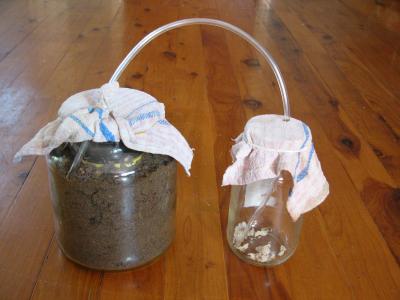Simple Science Projects - building an ant farm
by Marianne

Ant farm and feeding jar
Here's a simple science project you might like to make. Watching nature at work is one of life's greatest lessons. Especially the ant - Look at how he works all day, busy doing exactly what is needed for his community.
So, we decided to make an ant farm to watch them at work.
Here's how we did it:
1. Found two glass jars - 1 large one and 1 smaller one which could fit inside it.
2. Went into the bush (or garden) and found an ant nest. We lifted up rocks and dead tree branches looking for a good nest.
3. We collected as many ants as we could into a container. One way to do this is to place a container next to the ant nest with sugar or bread crumbs in it and wait until you have 100 or so ants.
4. Then we dug with a small trowel to find the queen ant. She is about 3 times bigger than the rest of the ants in the colony. One way of finding her is to sift the dirt onto a white paper sheet - so that you can identify her more easily. You must find the queen. Keep her separate for the moment.
5. We collected some of the dirt from this area.
6. We placed the small jar inside the large jar and filled the space between the two glass jars with some of the dirt we collected. We put the queen in the ant farm. Then it is time to let the other ants come into the colony. One way to do that is to place a piece of plastic tubing in the jar with the 100 or so ants you collected and feed it into the ant farm, or just open your glass container and coax them in gently without too much damage.
7. You can either leave some bread crumbs, or honey on the top of the ant farm for food or you can use the plastic tubing from the ant farm to another container which contains the food source as well as a wet sponge for moisture.
8. Cover the ant farm with a dark cloth. They are used to working underground.
9. Watch them build their tunnels , make rooms for their eggs and look after the queen.
At this stage of this simple science project, we are enjoying watching the ants make their tunnels, transport food and eggs, but we don't know where the queen is. Our ants are very tiny, so we may try this ant farm again with some larger ants to observe the process better.
I hope you have success with your ant farm.
Tell us about it.
Do you have a simple science project you have tried? Add it to the gallery.










